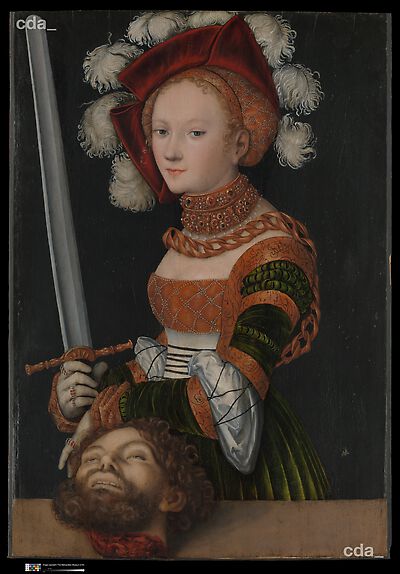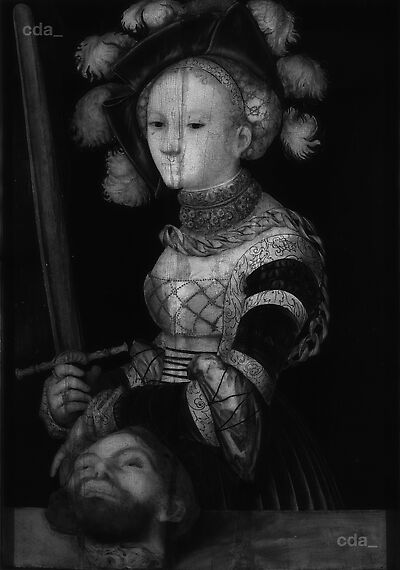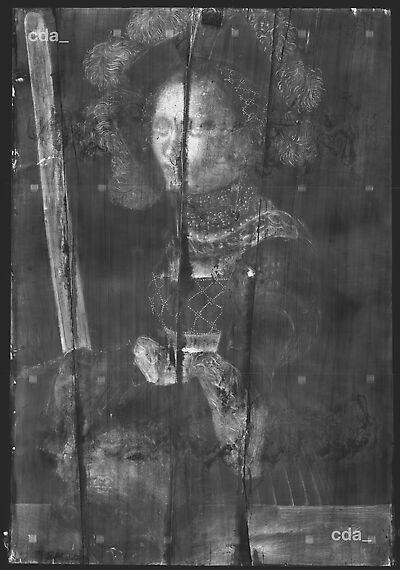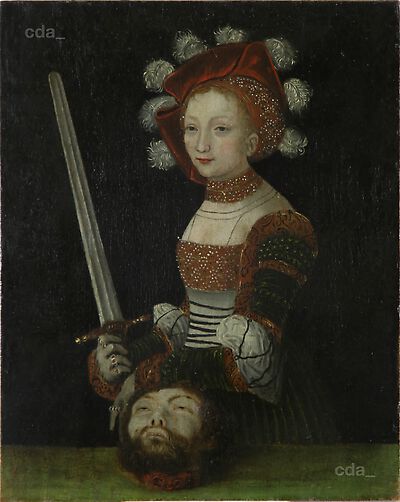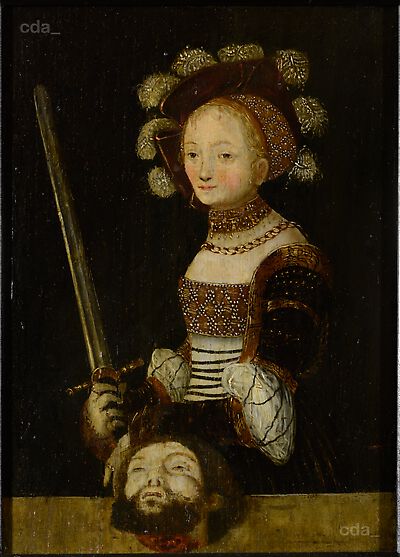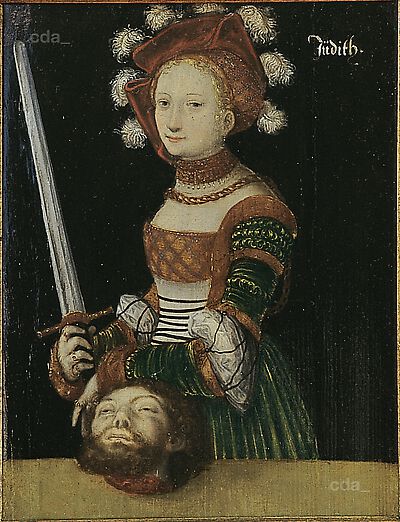The Metropolitan's Judith first became known in 1911, when it was purchased by the Museum from the estate of Robert Hoe. At that time, Holofernes's beard had been enlarged to cover his severed neck. After cleaning and restoration, the painting could be more readily compared with other examples of the same theme produced by Cranach and his workshop, notably those in the Kunsthistorisches Museum, Vienna (fig. 55), and the Staatsgalerie Stuttgart.[1] At the lower right, the Museum's panel shows a crowned serpent with raised wings and a ring in its mouth, the insignia Cranach employed before 1537. In addition, the technique and execution of the work, as described above, are entirely consistent with those of Cranach and his workshop in the early 1530s, a date also supported by Judith's costume.[2] The attribution to the artist has never been challenged, although greater scrutiny of his workshop may well lead to a more informed understanding of its participation in paintings such as this, which were produced in many versions.[3]
The Cranach workshop's serial production of paintings with this theme during the 1530s has raised intriguing questions about possible links between these pictures and the Saxon court. Because Judith is presented in contemporary dress and because her physiognomy varies from painting to painting, several scholars have suggested that these are portraits of court women in the guise of Judith.[4] David Oldfield, noting that only the sword and severed head of Holofernes separate a Cranach Judith from an official portrait, thought it likely that several women commissioned portraits of themselves in the role of the virtuous heroine.[5] If the Museum's Judith is a portrait,[6] then it is certainly idealized in the same manner as the Judith in the Kunsthistorisches Museum. Cranach's contemporaneous portraits, such as Princesses Sibylla, Emilia, and Sidonia of Saxony of about 1535 (fig. 56), show far greater attention to the distinctly different physiognomies of the sitters, who are more objectively observed and portrayed than the women in the Metropolitan and Vienna depictions of Judith.
Judith's popularity throughout the ages has led to various interpretations of her image. In medieval times, the moral emphasis of the narrative took precedence. Judith was equated with Humilitas and Continentia, who overpowered and destroyed Holofernes, representative of the deadly sins of Superbia and Luxuria. She was also seen as a symbol of Chastity and a prefiguration of the Virgin Mary as Ecclesia.[7]
In the sixteenth century, these associations evolved as Judith's story took on political implications. Gertrud Rudloff-Hille first proposed, in 1953, that Cranach's Judiths relate to the Schmalkaldic League — an alliance of Protestant princes formally established in Schmalkalden on February 27, 1531, to defend against the Holy Roman Emperor's advancements — as well as to the threat of a Turkish invasion.[8] Werner Schade further elaborated on this view and cited, as had Rudloff-Hille, two panels of 1531 in Gotha, Judith at the Table of Holofernes and The Death of Holofernes (Schlossmuseum, Schloss Friedenstein, Gotha).[9] He noted that theologians of the time, when asked whether disagreeing with the emperor accorded with Christian principles, would cite the Judith narrative and particularly her aim to free her country from the grip of tyrants. Supporting this theory, Schade identified the central standing figure of Judith at the Table of Holofernes as Philipp I, Landgrave of Hesse, a founder and coleader of the league.[10] Helmut Börsch-Supan broadened Schade's proposal by applying it to individual paintings of Judith, specifically an example from 1530 in the Jagdschloss Grunewald, Berlin, that is of the same type as the Museum's panel. He regarded such works as symbolic of the Schmalkaldic League and noted that no known examples date before the formation of the league.[11] Dieter Koepplin and Peter Gorsen qualified and elaborated upon Schade’s claims, [12] but twenty years later, in 1994, Schade himself altered his view, indicating that the threat of the Turkish invasion also had significance for the Gotha paintings.[13] Anja Schneckenburger-Broschek similarly made a strong case for the half-length Judith in Kassel dating to before 1537 (Museum Schloss Wilhelmshöhe) as a symbol of resistance to Turkish invasion.[14]
Equally important for other interpretations of the Judith paintings are their connections to the literature of the period.[15] As Henrike Lähnemann has recently pointed out, a number of anonymous German Meistersinger texts depict Judith as an active heroine, clever and cunning.[16] More specifically, certain broadsheets emphasized her dual nature as both virtuous, even beyond reproach, and dangerously seductive. In Lähnemann's view, 'the popular conception of Judith had developed into a permanent state of ambiguity by the sixteenth century, shaped by the divergent focuses of the short texts of the previous centuries.'[17] Certainly, this sense of ambiguity must have played well at the Saxon court and helped to guarantee the popularity of the Judith representations.
Judith's dual nature sheds further light on the moralizing interpretations of the story. Along with other figures from ancient history and the Bible, Judith used her considerable charms to dominate and even destroy men. The themes commonly known as Weibermacht and Weiberlisten (power of women, wiles of women) were already well established in the literature of the late medieval period as well as in its prints and decorative arts. Cranach was among the first sixteenth-century artists to take up these themes in painting, both in half-length figures, such as Judith and Salome, and in more developed narrative scenes, including Lot and His Daughters and Aristotle and Phyllis.[18] The introduction of this new medium for depicting the theme raises the question of how the paintings were used and displayed.[19] Was the Museum's painting, for instance, meant to hang alone or in a series of Weibermacht / Weiberlisten themes? Unfortunately, our picture provides no clues as to how it was originally installed. For now, in the absence of further evidence, Judith with the Head of Holofernes can be considered a prime example of one of the most important themes in Saxon court art, one that remains as multivalent in meaning as it perhaps did in its own time.
[1] The Stuttgart Judith is no. 643 (Guido Messling in Brussels and Paris 2010 – 11, pp. 212 – 13, no. 114, ill. p. 238).
[2] Those scholars supporting a date in the 1530s are Max J. Friedländer and Jakob Rosenberg (1932, p. 65, no. 190e; Friedländer and J. Rosenberg 1978, p. 115, no. 230E), between 1526 and 1537; Charles Kuhn (1936, p. 38, no. 100), between 1530 and 1535;
and Harry Wehle and Margaretta Salinger (1947, p. 202), about 1530.
[3] See Heydenreich on Cranach’s workshop production (Heydenreich 2007b, especially pp. 289 – 301). There are two smaller, inferior copies of the Museum’s painting: one in Sao Paulo (18.5 × 15.5 cm; photograph in curatorial files, Department of European Paintings, MMA) and the other in the Goudstikker Collection (21 × 15.5 cm, returned to the Goudstikker heirs as of 2006).
[4] Robert Allerton Parker called the Museum’s painting “predominantly a portrait” (R. A. Parker 1927, p. 17). Karl Schütz (in Vienna 1972, p. 24) understood the Vienna and Stuttgart versions as “historically disguised portraits,” although Heinrich Zimmermann saw them only as Judiths in contemporary dress (H. Zimmermann 1969, p. 284). Helmut Börsch-Supan (1974, p. 418) even suggested that the Vienna and Stuttgart portraits represent the same woman, who is also depicted in Portrait of a Woman (Waldemar von Zedtwitz Collection, New York).
[5] Oldfield 1987, pp. 9, 10, n. 4.
[6] In characterizing the Metropolitan’s painting as “predominantly a portrait,” Parker noted the lack of emotional expression in the figure (R. A. Parker 1927, pp. 17, 24).
[7] For the view of Judith in the Middle Ages through the end of the fourteenth century, see Schreyl 1990b, pp. 195 – 203.
[8] Rudloff-Hille 1953, p. 35.
[9] Schade 1972b, p. 374; Schade 1974, p. 58; Schade 1980, p. 58.
[10] Berlin 1983, p. 304, nos. E 17.1, E 17.2.
[11] H. Börsch-Supan 1974, p. 417. Judith with the Head of Holofernes and Two Attendants of 1525 (Gustav Rau Collection, UNICEF Germany, on deposit in the Arp Museum Bahnhof Rolandseck, Remagen [GR 1.691]; Basel 1974, vol. 1, p. 227, fig. 143) would
be an exception to this theory.
[12] Koepplin in Basel 1974, vol. 2, p. 578; Gorsen 1980, p. 74.
[13] For Schade’s opinions, see Gotha 1994, p. 23, under no. 1.4. Kristin Eldyss Sorensen Zapalac rejected Schade’s supposition, suggesting instead that Lucretia had become the symbol of the Protestant cause (Zapalac 1994, pp. 57 – 58; see also Zapalac 1990,
pp. 120 – 26, 128). It must be admitted that no known contemporary document identified Judith as a Schutzpatron of the Protestant position.
[14] Schneckenburger-Broschek 1997, pp. 70, 73 – 74.
[15] See especially Baltzer 1930; Seibert 1970; Strumwasser 1979, pp. 107 – 13; Straten 1983, pp. 19 – 21; Bernadine Ann Barnes in Washington 1990 – 91, pp. 60 – 73; Zapalac 1994; Löcher 1999, p. 32.
[16] Lähnemann 2010.
[17] Ibid., pp. 251 – 52.
[18] On Cranach’s depictions of the Weibermacht and Weiberlisten themes, see Koepplin in Basel 1974 , vol. 2, pp. 562 – 85; Straten 1983, pp. 30 – 33, 34 – 35, 41 – 45, 46 – 50; Barnes in Washington 1990 – 91, pp. 60 – 73; Zapalac 1994; Hammer-Tugendhat 1997; Aikema 2010; Véronique Bücken in Brussels and Paris 2010 – 11, pp. 54 – 65; Joachim Jacoby in Rome 2010 – 11, pp. 224 – 33, nos. 29 – 31.
[19] Sometimes mentioned in this regard is a 1507 description of Schloss Wittenberg in which such scenes are reported as hanging in the bedroom of Johann, Duke of Saxony (see Basel 1974, vol. 2, p. 563; published in Bauch 1894, pp. 431 – 32). However, Peter Strieder (2005) argued that the 1507 source may be largely fictional.
[Ainsworth, Cat. New York 2013, 63, 287, No. 13]

